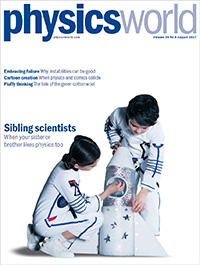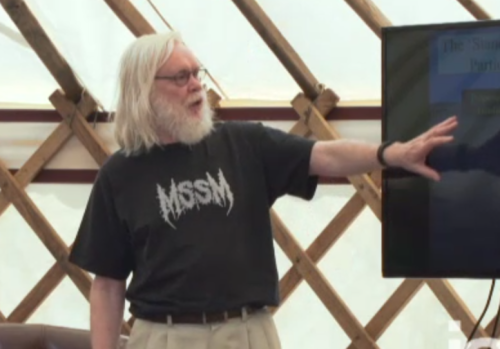Tag archives: Higgs boson
The August 2017 issue of Physics World is now out
 By Matin Durrani
By Matin Durrani
Who inspired you to study physics? Perhaps you had a great teacher or a supportive parent. But how might it feel if you’ve got a sibling who’s also into the subject? Would they be your rival or would the two of you support and nurture each other?
These issues facing “sibling scientists” are the cover feature of the August issue of Physics World magazine, which is now out. Turns out that sibling scientists are generally a force for good, especially with the elder child acting as a mentor and guide – often providing information, support and advice to the younger sister or brother.
I wonder in fact if we should do more to encourage boys and girls who are already in thrall with physics to persuade their siblings into the subject too. Of course, our feature isn’t an exhaustive scientific study, so do tell us if you know of other examples of sibling science.
Remember that if you’re a member of the Institute of Physics, you can read Physics World magazine every month via our digital apps for iOS, Android and Web browsers.
View all posts by this author | View this author's profile
John Ellis on physics after the Higgs boson, calculating the loudness of the Big Bang, the chemistry of ironing

Looking ahead: John Ellis on the future of particle physics. (Courtesy: IAI TV)
By Hamish Johnston
In 2012 particle physicists gave themselves a giant pat on the back when the Higgs boson was discovered at the Large Hadron Collider at CERN – nearly 50 years after it was first predicted to exist. But what have particle physicists done since, and what does the future hold for the field? In a video called “After the Higgs boson: what’s next for 21st century physics?” from the Institute of Art and Ideas, the theoretical physicist John Ellis charts the future course of particle physics. Pay attention for a joke about the UK’s foreign secretary Boris Johnson.
View all posts by this author | View this author's profile
Dinner that’s out of this world, Higgs pizza and a cosmic symphony
By Michael Banks and Tushna Commissariat
Before setting off to the International Space station (ISS) for six months, UK astronaut Tim Peake revealed that one of the meals he would miss most is the classic British roast dinner. So what better way to celebrate the 44 year old’s safe return to Earth last month than to create a portrait of him made from his favourite nosh? Designed by UK “food artist” Prudence Staite for the Hungry Horse pub chain, the culinary creation took 20 hours to make – you can watch a timelapse video of it being created above. The finished portrait weighed in at 12 kg and says “Welcome Home Tim”. Hungry Horse has even offered Tim and his family free roast dinners for life.
View all posts by this author | View this author's profile
And the winner is: our 2015 Nobel-prize predictions

Psychic world: we have another go at predicting the Nobel winners. (Courtesy: iStockphoto/shutter_m)
By Tushna Commissariat and Hamish Johnston
Update: Looks like we were quite spectacularly wrong this time around with our predictions as this year’s Nobel has been awarded to Arthur McDonald and Takaaki Kajita “for the discovery of neutrino oscillations, which shows that neutrinos have mass”. While Physics World’s news editor Michael Banks did predict this in 2013, we did not think this would be the year. Clearly, as our “Which physics disciplines attract the most Nobel prizes” infographic suggests, the field of particle physics still seems to be the most Nobel-worthy one.
It’s a mug’s game, we know, but come the start of October we just can’t resist trying to predict who will win the Nobel Prize for Physics, which this year will be announced on Tuesday 6 October.
With the exception of 2013 – when most pundits were right in thinking that the prize would be related to the 2012 discovery of the Higgs boson – predicting the next Nobel winners (or winners) is a tough call. If you want to take an analytical approach, check out the infographic we published last year: “Which physics disciplines attract the most Nobel prizes”. It suggests that the field of atomic, molecular and optical physics is due a prize, and one of us (Hamish Johnston) thinks an excellent bet is Deborah Jin for her work on fermionic condensates. If Jin were to win, she would be only the third woman ever to win a physics Nobel – the other two being Marie Curie in 1903 and Maria Goeppert-Mayer in 1963.
Maria Spiropulu talks about multiple Higgs beyond the Standard Model
By Hamish Johnston in Waterloo, Canada
Caltech’s Maria Spiropulu has a great party trick. She can demonstrate the bizarre rotational property of a spin ½ particle using a full glass of water and a contortion of her arm without spilling a drop. This was just one of the many highlights of her talk about the future of experimental particle physics that she gave yesterday at the Convergence meeting here at the Perimeter Institute.
While Spiropulu doesn’t talk about spin in the above video, she does explain why she is looking forward to analysing data from the 13 TeV run of the Large Hadron Collider, where she is part of the CMS collaboration. So, what could Spiropulu and colleagues find when they dig into the vast amounts of data that CMS is currently producing? It just could be four more types of Higgs particle. To find out more watch the video.
View all posts by this author | View this author's profile
Seven lessons from Sean Carroll

Sean Carroll in full flow at the 2014 Cheltenham Science Festival.
By Matin Durrani in Cheltenham
I made the short journey yesterday from Bristol to the regency spa town of Cheltenham, which this week is hosting its annual science festival. One of the largest such events in the UK, it’s been running since 2002 and has a packed programme of A-list speakers and topics ranging from genetics to geology, from cocktails to cake, and from the human brain to the Higgs boson.
My main reason for attending the festival, though, was to meet Caltech physicist Sean Carroll, whose book about the search for the Higgs boson (called The Particle at the End of the Universe ) was picked by Physics World last year as one of our top 10 books of 2013. Carroll was in the Gloucestershire town to give a one-hour talk about the Higgs, although the festival organizers were clearly working him hard as he also spoke in separate lectures on dark matter and dark energy, and on his role as a science adviser to Hollywood. (Carroll’s worked on films including Thor, Avengers Assemble and TRON: Legacy and even played a tiny role on TV’s The Big Bang Theory – stay tuned for more on that in our upcoming audio interview with him.)
View all posts by this author | View this author's profile
Particle man meets universe man
By Margaret Harris
When particle physicist Jon Butterworth and cosmologist Pedro Ferreira took the stage last night at the Bristol Festival of Ideas, they did so as representatives of the two pillars of modern physics. Butterworth, a leading member of the ATLAS collaboration at CERN’s Large Hadron Collider, spoke about the discovery of the Higgs boson and the effort to understand the nature of matter on the quantum level. Ferreira, a theorist at the University of Oxford, focused on Einstein’s general theory of relativity, which describes the behaviour of colossal objects such as galaxies and black holes.
The equations of quantum mechanics and general relativity are famously incompatible, but far from starting a Harry Hill-style confrontation (“FIIIIGHT!”), the advocates of the two theories shared the stage amiably, fielding questions from audience members and talking about their respective new books (Smashing Physics for Butterworth, The Perfect Theory for Ferreira). You can hear Ferreira and Butterworth’s responses to some common (and not-so-common) questions in the clips below.
Student behaviour in the MOOCosphere

Does student behaviour online mirror the traditional classroom? (Courtesy: Shutterstock/wavebreakmedia)
By James Dacey
I’ve written a few times recently about the rise of massive open online courses, or “MOOCs” for short. If this trend in education has so far passed you by, MOOCs are online courses generally offered free of charge by some of the leading universities in the world. For example, Massachusetts Institute of Technology offers courses in classical mechanics and electricity & magnetism, and the University of Edinburgh has recently launched a course about the discovery of the Higgs boson.
MOOCs tend to combine video lectures with assignments such as problem sets and extended projects. In many ways, the course formats mirror or complement traditional classroom-based education, incorporating features such as forums where students can discuss the course content amongst themselves. Some of the science courses even include online “practicals” by way of virtual laboratories. But despite the proliferation of MOOCs in the past few years, very little research has been carried out on the way that students are actually engaging with the courses.
Now, a group of researchers in the US has done the first relatively detailed study of student behaviour in the MOOCosphere. The study is described in a paper published on the arXiv preprint server with lead author Ashton Anderson, a computer scientist at Stanford University. Anderson and his team examined the behaviour of the student population in courses offered by Stanford through Coursera, one of the major MOOC providers. The courses were on the topics of machine learning and probabilistic graphical models. After reading the study, it seems to me that the “take away” message is that MOOC students have many different motivations for taking these courses and as a result they behave in an assortment of ways, distinct from classrooms in the real world.
View all posts by this author | View this author's profile
Homework help from NASA, rescue missions, top technologies and more
By Tushna Commissariat
Who doesn’t like a bit of help with their homework – not 4-year-old Lucas Whiteley from West Yorkshire in the UK. When faced with some tough and rather complex scientific questions, the enterprising child filmed a video of himself asking the US space agency NASA for some help. And much to his delight, he got a video response courtesy of NASA engineer Ted Garbeff of the Ames Research Center in California. In the 10-minute video, Garbeff answers Whiteley’s questions including “How many stars are there?” and “Did any animals go to the Moon?” Of course, the story garnered nation-wide interest and was covered by the Huffington Post, the Telegraph and others. Take a look at Garbeff’s response video above.
View all posts by this author | View this author's profile
Physics World 2013 Focus on Big Science is out now
By Michael Banks

Physics World Focus on Big Science.
All eyes will be on Stockholm next week as the 2013 Nobel Prize for Physics is announced. One of the frontrunners for the prize in the minds of the Royal Swedish Academy of Sciences will surely be the discovery last year of the Higgs boson at CERN’s Large Hadron Collider (LHC).
But the LHC story is far from over and in the latest Physics World focus issue on “big science” find out how the LHC will hunt for new particles beyond the Higgs boson once the collider restarts in 2015 following an 18-month repair and upgrade programme at the Geneva-based lab.
All full members of the Institute of Physics will receive a print edition of the focus issue along with their copy of the October issue of Physics World, but everyone can access a free digital edition. The focus issue also looks at how particle physicists are already thinking about what could come after the LHC, with bold plans for a 80–100 km proton–proton collider. There are even plans for a collider based on lasers, with an international team looking at creating an array of “fibre lasers” to be used as a future “Higgs factory”.